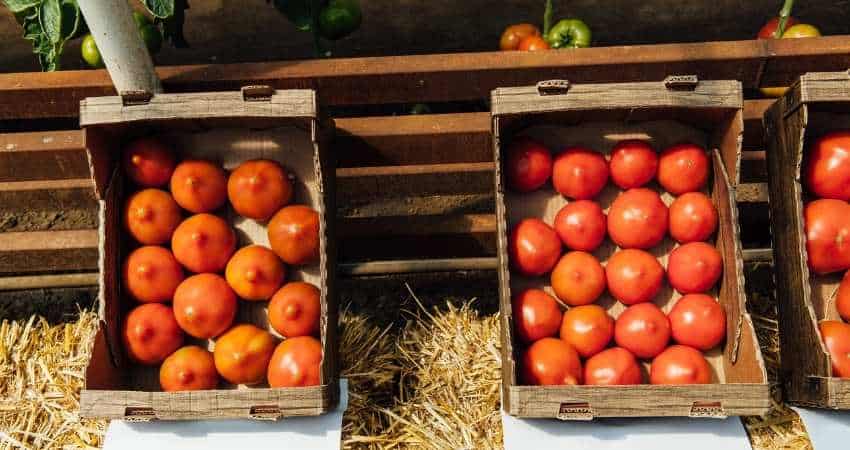This Is How To Properly Store Tomatoes
Unfortunately, not everyone who loves tomatoes knows how to store them. The process is different for each type of ripened tomato. Therefore, how to properly store tomatoes?
How to properly store tomatoes depends on their ripeness. Overripe tomatoes are best stored in the refrigerator. Perfect, ready-to-eat tomatoes can be left out but shouldn’t be in the sun. Green tomatoes should be stored in a container in a cool area until they’re ripe.
In this article, I’ll go more in-depth into how exactly you should store your tomatoes depending on their level of ripeness. In addition, I’ll show you how to freeze tomatoes for the long haul.
How To Store Overripe Tomatoes

Cool, dark spaces like basements are great places to store overripe tomatoes for several extra days of life. If you don’t have a cellar, you’ll have to use your refrigerator instead.
Under normal circumstances, refrigerating tomatoes isn’t optimal1. However, if they’re getting overripe and squishy, the fridge is your best chance to save them.
When refrigerating, preparation is critical.
Clean Them With a Soft Cloth & Remove Stickers
Although you don’t want to wash tomatoes before storing them, you can wipe them down with a soft cloth or paper towel. Get rid of most of the dirt, and if they’re store-bought tomatoes, peel off any stickers attached to them.
Cut Off the Stems and Vines
You’ll want to place the tomatoes upside down, more on this in step three, therefore, trim the stems as much as possible. If you have tomatoes on the vine, cut the vines as well. When storing them, you want only the round, red tomato.
Place Them Upside Down on a Dish & Not Touching
When placing your tomatoes on the plate, sit them upside down leaving a bit of space between each one. You can add more than one to a plate, but you don’t want them touching. Overripe tomatoes bruise very easily, and the best way to avoid this is to keep them apart.
As for storing them upside down, this will help keep them as juicy and fresh as possible. While tomatoes are naturally plump and juicy, they can lose moisture through the top area where they were attached to the vine.
By placing them upside down, you ‘lock in’ the water, keeping them from drying out and going bad.
Remove Them a Few Hours Before Serving
When kept in this way, tomatoes can usually last two or three extra days. The refrigeration process causes them to lose some of their moisture and flavor2.
If you want them to taste as good as possible, remove them a few hours before you plan on eating them3.
Let them sit out long enough to reach room temperature, and they’ll taste better than eating them straight from the fridge.
How To Store Perfectly Ripe Tomatoes
If you plan to eat or use your ripe tomatoes within the next few days, leaving them on the countertop is fine4. You should trim the stems and place them upside down on a plate somewhere away from the sun5.
Covering them is unnecessary, but if you want to keep them clean, cover them with something light like paper towels or paper plates.
If you picked or purchased an excess of tomatoes but don’t plan on using them for several days to a week, consider using the refrigerator method listed above for overripe tomatoes.
While you might lose a little of the vibrant taste, you’ll give them several additional days of life. You don’t have to refrigerate them immediately. Leave them out a few days first to cut back on the time they’ll be in the fridge.
How To Store Green/Unripe Tomatoes
When it comes to storing green tomatoes, you may also want to speed up the ripening process. The good news is you can easily do both.
Simply take the green tomatoes and place them upside down in a paper sack or covered container. Then roll up the bag or put the lid on the box and set them aside in a cool area away from the sun. They should ripen in a few days.
Check out this YouTube video to see this method in action:
You may have noticed they placed a banana in the bag on top of the tomatoes. If you want your tomatoes to ripen as fast as possible, this is one of the best things you can do. Of all fruits, bananas release the most ethylene gas which kicks the ripening process into overdrive6.
Therefore, whether you store your green tomatoes in a cardboard box or paper bag, throw a banana in for good measure.
Many people keep tomatoes with onions because they go together in many salads and recipes. Therefore, find out if they can be stored together in my blog post, Can You Store Tomatoes With Onions. You’ll be surprised at what you should do!
How To Store Cut Tomatoes
If you’re looking for a way to store sliced tomatoes or tomato halves, the refrigerator is your best bet7. You can keep diced tomatoes in Ziplock bags or any sealable container. Tomato halves should be placed on a paper towel with the cut side down in a storage container.
How To Freeze Tomatoes
If you have more tomatoes than you could possibly eat, there are several options on what to do with them. You can make tomato juice or tomato sauce, can them or freeze them.
How to Wash, Hull, and Seal Tomatoes
There are two different ways to freeze tomatoes. This video by the University of Maine shows the easiest way:
As you can see from the video, this method requires nothing more than washing, hulling, and sealing them in an airtight container or Ziplock-type bag.
How to Blanch Tomatoes
If you want to freeze your tomatoes for long-term storage, blanch them first8. If you’re not sure what that means, don’t worry. I’m going to give you a step-by-step version I learned when first learning to freeze tomatoes:
- Fill an eight-quart pot with water.
- Bring the water to a boil.
- While waiting for the water to boil, prepare your tomatoes. Do this by trimming off all stems and leaves and cutting an ‘X’ on each tomato’s bottom.
- When the water’s boiling, gently place your tomatoes in the pot.
- Cook for a couple of minutes. When the skins begin to split, it’s time to remove them.
- Remove each tomato with a large spoon and put them directly into a bowl of ice water.
- Once they’ve cooled completely, hull the tomatoes from the stem-end.
- Remove the peels.
- Put them in airtight containers or freezer bags. Leave room for expansion.
- Label your bag or container, and freeze the tomatoes for up to a year.
Read Next – More Food Storage Articles For You!
Should Carrots Be Stored In Water?
The Complete Guide To Food Storage Processes
Can Extra Virgin Olive Oil Go Bad? What You Need To Know
The Best Food Storage For Dorm Room Ideas
- Purdue University: Optimal Storage Conditions for Vegetables [↩]
- University Of California: Tomatoes [↩]
- Clemson Cooperative Extension: Using & Storing Tomatoes [↩]
- University of Maryland Extension: Tomatoes [↩]
- Ohio State University Extension: Selecting, Storing, and Serving Ohio Tomatoes [↩]
- Wikipedia: Ethylene gas as a plant hormone [↩]
- Michigan State University: Using, Storing and Preserving Tomatoes [↩]
- Better Homes & Gardens: How to Freeze Tomatoes to Savor Them All Year [↩]
